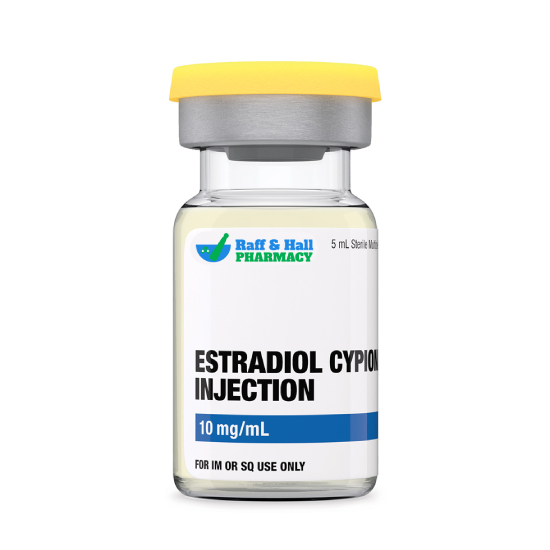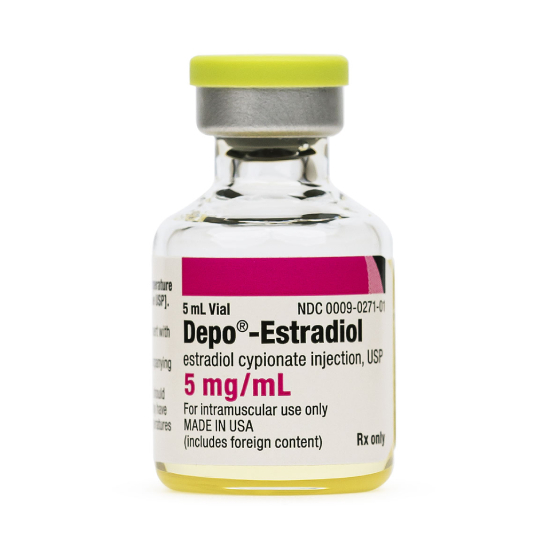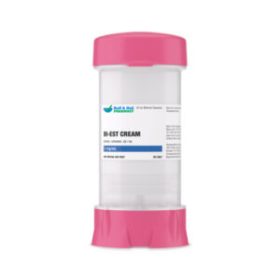Estradiol Cypionate Injection (Grapeseed Oil) (5 mL Vial)
Estradiol Cypionate Injection (5 mL Vial) †
† commercial product
Estradiol cypionate injection is a form of estrogen therapy used to help women whose bodies are not producing enough estrogen naturally. It’s often prescribed for menopausal symptoms like hot flashes, night sweats, and vaginal dryness. It’s also used in certain cases for hormone replacement therapy or to support bone health and prevent osteoporosis. The injection is administered by a healthcare provider, and the hormone is slowly released into the bloodstream, providing steady relief from symptoms over time. As with any hormonal treatment, it should be used under medical supervision, following the doctor’s guidance to ensure safety and effectiveness.
Once injected, estradiol cypionate is absorbed into the bloodstream and binds to estrogen receptors throughout the body. Estrogen plays a vital role in regulating reproductive health, bone density, skin condition, and cardiovascular function. By replenishing estrogen levels, the injection helps restore balance in the body’s hormonal system. It works by improving blood flow, supporting collagen production, and reducing symptoms associated with low estrogen, such as dryness and thinning tissues.
Estradiol cypionate should not be used by women with certain health conditions. These include hormone-sensitive cancers like breast or uterine cancer, unexplained vaginal bleeding, liver disease, or a history of blood clots or stroke. Women who are allergic to estrogen or any ingredient in the injection should avoid it. If you have conditions such as heart disease, high blood pressure, or migraines, your doctor may need to monitor you closely. Always share your full medical history before starting this treatment to ensure it’s safe for you.
While estradiol cypionate can be beneficial, it may also cause side effects. Some women experience breast tenderness, headaches, nausea, bloating, or mood swings. In rare cases, more serious problems such as blood clots, stroke, or liver issues may arise. If you notice chest pain, shortness of breath, or sudden vision changes, seek medical help immediately. Regular checkups and communication with your healthcare provider can help manage these risks and ensure the treatment works well for you.
Estradiol cypionate injection is not recommended for pregnant women because it can interfere with fetal development. Women who are pregnant or planning to become pregnant should avoid this therapy unless directed otherwise by a doctor. For breastfeeding mothers, there is a chance that the hormone could pass into breast milk, potentially affecting the baby. If you are nursing, consult your healthcare provider to determine the safest treatment option for you and your child.
Store this medication at 68°F to 77°F (20°C to 25°C) and away from heat, moisture and light. Keep all medicine out of the reach of children. Throw away any unused medicine after the beyond use date. Do not flush unused medications or pour down a sink or drain.
- Cui, J., Shen, Y., Li, R., “Estrogen synthesis and signaling pathways during aging: from periphery to brain”, Trends in molecular medicine, vol.19 issue 3, pp 197–209, 2013. Available: https://doi.org/10.1016/j.molmed.2012.12.007.– LinkOpens in New Tab
- Roby, K.F., “17 Beta Estradiol”, Reference Module in Biological Sciences. Available: https://www.sciencedirect.com/science/article/pii/B978012801238398019X– LinkOpens in New Tab
- Reed BG, Carr BR, “The Normal Menstrual Cycle and the Control of Ovulation.” [Updated 2018 Aug 5].. Endotext [Internet]. 2000-. Available from: https://www.ncbi.nlm.nih.gov/books/NBK279054/– LinkOpens in New Tab
- Stevenson JC, “Type and route of estrogen administration”, Climacteric: The Journal of the International Menopause Society, vol. 12 issue Suppl 1, pp 86-90. Available: https://www.tandfonline.com/doi/abs/10.1080/13697130903007389?journalCode=icmt20– LinkOpens in New Tab
- Lee HR, Kim TH, Choi KC, “Functions and physiological roles of two types of estrogen receptors, ERα and ERβ, identified by estrogen receptor knockout mouse”, Lab Animal Research, vol.28 issue 2, June 2012. Available: https://www.ncbi.nlm.nih.gov/pmc/articles/PMC3389841/– LinkOpens in New Tab
- Paterni, I., Granchi, C.,Katzenellenbogen, J.A., “Estrogen Receptors Alpha (ERα) and Beta (ERβ): Subtype-Selective Ligands and Clinical Potential”, Steroids, vol.0, November 2014. Available: https://www.ncbi.nlm.nih.gov/pmc/articles/PMC4192010/#:~:text=The%20physiological%20functions%20of%20estrogenic,to%20associated%20DNA%20regulatory%20sequences.– LinkOpens in New Tab
- Cui, J., Shen, Y., Li, R, “Estrogen synthesis and signaling pathways during aging: from periphery to brain.” Trends in molecular medicine, vol.19 issue 3, pp.197–209, 2013. Available: https://doi.org/10.1016/j.molmed.2012.12.007– LinkOpens in New Tab
- Kuhl, H., “Pharmacology of estrogens and progestogens: influence of different routes of administration” Climacteric: The Journal of the International Menopause Society, vol. 3 issue Suppl 1, pp. 3-63
- ”Estradiol – Drug Summary”. Prescribers’ Digital Reference. Available: https://www.pdr.net/drug-summary/Estradiol-estradiol-1966.1610– LinkOpens in New Tab
- Hemminki, E., Gissler M., Toukomaa, H., “Exposure to female hormone drugs during pregnancy: effect on malformations and cancer” British Journal of Cancer, vol.80 issue 7, pp. 1092-1097, 1999. Available: https://www.ncbi.nlm.nih.gov/pmc/articles/PMC2363045/pdf/80-6690469a.pdf– LinkOpens in New Tab
- ”Estradiol”. Available: https://www.drugs.com/pro/estradiol.html#LINK_3f333729-d1ab-4413-883b-9f6c50383330






